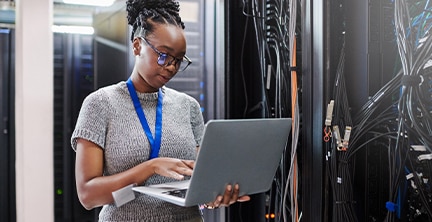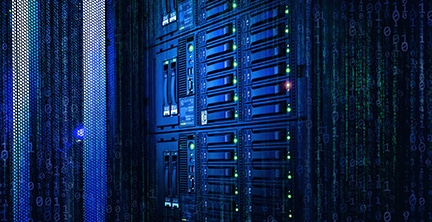March 08, 2022
IT Modernization Provides Better Outcomes for Citizen Services
An infrastructure that supports digital transformation can greatly improve the delivery of citizen services for state and local government agencies.
IN THIS ARTICLE
The Power of Automation
The Elements of a Modernized IT Environment
IT Modernization in Action
The Need for IT Modernization
Digital transformation is driving the need for IT modernization in organizations in every sector, and state and local government is no exception. In particular, the COVID-19 pandemic put pressure on government agencies to quickly roll out digital solutions to streamline services.
According to NASCIO’s 2021 State CIO Survey, 94 percent of state technology leaders say the pandemic increased the demand for digital government services (53 percent say that this demand increased “dramatically”). In fact, one state IT leader characterizes the race to set up new technology as “10 years’ worth of deployments in eight months.” According to the survey, the desire to create a better online experience for citizens, at 74 percent, was by far the biggest driver for this digital acceleration, followed by public participation; optimizing operations and lowering costs; increasing employee productivity; and improving collaboration among agencies.
Digital transformation continues to evolve as a concept. More organizations are adopting DevOps to improve agility and increase collaboration between software development and operations teams. Organizations are also moving toward increased automation of data center processes, especially regarding infrastructure as code (IAC).
Both shifts are part of the more general movement toward a focus on software in IT infrastructure. As software grows more sophisticated, hardware becomes more simplified and even commoditized. Still, hardware decisions are an important aspect of IT modernization efforts, and these choices should focus on the specific needs of a given use case. One agency might opt for hyperconverged infrastructure (HCI) to enable scalability, for instance, while another might need high-performance computing equipment to support specialized applications.
As always, cybersecurity should be a top concern when state and local governments seek to modernize their environments. Immutable storage helps defend against ransomware by ensuring an agency has a good copy of its data; indelible storage is data that cannot be deleted, adding another layer of protection.
KEY TRENDS IN IT MODERNIZATION
As state and local governments plan for IT modernization, they should consider objectives such as DevOps, digital transformation and hybrid work.
By combining software development and IT operations, DevOps helps to shorten the development lifecycle, provide continuous delivery and improve quality.
Digital transformation — the process of integrating digital technology throughout an organization — promotes transparency, improves employee productivity and simplifies access to services for citizens.
In the wake of the COVID-19 pandemic, more organizations are implementing digital work models that allow employees to work from home or at the office.
The Power of Automation
The phrase “do more with less” is practically a mantra in state and local government, where budgets often increase at a lower rate than the cost of providing services. Automation allows IT shops to put this mantra into action, and 35 percent of public sector IT professionals say that enabling automation is one of their top three priorities.
INFRASTRUCTURE AS CODE
By allowing organizations to manage and provision their infrastructure through code instead of through manual processes, infrastructure as code can boost automation and productivity. Before IAC, IT shops needed to manage infrastructure changes through complex, time-intensive work. But with IAC, infrastructure management can be automated, cutting costs and redirecting staff to more mission-critical projects.
CHATBOTS
Automated chatbots that answer questions from citizens were relatively rare in state, county and local government before the pandemic. But now, nearly all states — and many cities and counties — are either using chatbots or plan to deploy the technology soon. Chatbots are helping governments field questions on taxes, driver’s licenses and unemployment claims, among other topics.
DATA CENTER AUTOMATION
A step beyond IAC, data center automation encompasses scheduling, monitoring, maintenance and application delivery. By embracing data center automation, state and local government agencies can deliver services on demand and in a repeatable manner that’s better for their end users. Application programming interfaces (APIs) are a crucial component of automated tasks such as configuration management.
SMART CITIES
Smart city technology has grown increasingly practical. Many municipalities start with smart, highly efficient street lighting systems that have rapid ROI due to reduced energy costs, and then grow their smart city programs with pilot projects. Smart city technology can be used to monitor air quality, detect gunshots, optimize waste collection routes and streamline traffic. After Pittsburgh adopted smart traffic signals, wait times at intersections dropped by 41 percent.
ARTIFICIAL INTELLIGENCE
Artificial intelligence and machine learning are transforming work processes across industries. In government, AI can be deployed to answer routine questions about processes such as registering a business; run license plate numbers and background checks; predict equipment failure; and support 311 call centers by routing specific callers to the agents best able to help them.
CYBERSECURITY
As cyberthreats grow in number and sophistication, manual cybersecurity operations have become a strain on IT staffers. In fact, the attacks themselves are now mostly automated, and automation is often the only way that organizations can keep up. Next-generation, automated cybersecurity tools can help correlate data, detect infections and generate new protections before an attack can spread.
PATCH MANAGEMENT
Failure to patch and update IT systems is a major source of cybersecurity vulnerabilities for many organizations, but state and local governments often lack the staff necessary to stay on top of patch management. Automated patching tools can scan for missing patches, download patches as vendors release them and deploy patches without causing workflow disruption.
ROBOTIC PROCESS AUTOMATION
Robotic process automation applies computer code to automate otherwise manual workflows. By automating rote tasks, governments can save money and free up workers across departments for more valuable activities. Already, agencies are using RPA to transfer funds, enter data, process applications for benefits, manage invoices and onboard new employees.
Learn how to set up your IT modernization project for success.
Transforming IT to Meet Changing Demands
60%
The percentage of state CIOs who say the pandemic accelerated deployment of their legacy IT modernization strategy
67%
The percentage of state CIOs who say they implemented an agile project development methodology for IT modernization efforts
69%
The percentage of state CIOs who say they have a strategy for moving applications to the cloud
94%
The percentage of state CIOs who say the pandemic increased demand for digital government services
Source: NASCIO, "Driving Digital Acceleration: The 2021 State CIO Survey" (PDF), October 2021
The Elements of a Modernized IT Environment
To effectively implement an IT modernization strategy, state and local governments must make wise investments in technologies that meet the needs of their internal users and the citizens they serve. Cost is an important consideration, as always, but organizations must also select high-performing, flexible solutions that will help to future proof their environments.
Building Blocks
A comprehensive IT modernization strategy will take into consideration a variety of elements that must work together to deliver the necessary outcomes.
NETWORKING
Software-defined networking is becoming an essential part of IT infrastructure for many government organizations. SDN reduces not only organizations’ dependence on expensive hardware, but also the personnel hours required for tasks such as provisioning, software updates and maintenance. SDN also vastly improves scalability.
HYPERCONVERGENCE
Vendors of hyperconverged infrastructure now offer cloud-integrated centralized management consoles and also support DevOps tools directly on the HCI platform. Many government agencies adopt HCI for the benefits of simplified deployment, streamlined management and rapid scalability. Total cost of ownership may also be reduced in a hyperconverged environment.
STORAGE
For organizations with latency-sensitive applications, flash storage has become a must-have, especially as the price of all-flash arrays has dropped in recent years. For other applications, savvy IT leaders are adopting tiered storage in the public cloud, both as a budget-friendly way to add capacity and as a method for backing up their data.
WI-FI 6 & 5G
At the same time that worker mobility has become the norm, new wireless connectivity standards are enabling higher-than-ever performance. By adopting tools that are compatible with Wi-Fi 6 and 5G, state and local governments can ensure their employees have rapid access to the data and tools they need to do their jobs.
COMPUTE
Modernized applications require modernized hardware. For instance, graphics processing units are becoming increasingly important for AI use cases. Using GPUs, data scientists can significantly speed up deep-learning training while shrinking processing times from days or weeks to just hours. Containerization is another important technology and is crucial for organizations looking to build cloud-native applications.
SECURITY AND VISIBILITY
According to some recent reports, security concerns are actually a top driver of IT modernization in government. The proliferation of resources in multiple on-premises and public cloud environments has led to a lack of visibility that can exacerbate cybersecurity vulnerabilities. Along with implementing dedicated cybersecurity tools, governments can boost security by investing in infrastructure with built-in security features.
CLOUD
Many government organizations initially resisted the public cloud due to security concerns. Even today, existing investments in legacy IT environments prevent some governments from migrating resources to the public cloud. However, there has been substantial improvement in interactions between onsite processing/storage and public cloud resources, which is driving greater adoption of cloud services.
END-USER DEVICES
By modernizing their fleet of employee devices, state and local governments can boost employee productivity, enable remote work and take advantage of biometric security features. Device as a Service programs, offered by third-party partners, allow agencies to switch to an operating-expense financing model while giving users access to ongoing support.
Learn how CDW•G can help your government agency find the technology solutions to modernize its IT infrastructure.
The State of the Cloud in the States
Nearly all state IT departments now use the public cloud in some capacity, but maturity levels vary widely, according to a report from NASCIO.
17%
The percentage of states that have a container strategy in place; 31 percent have such a strategy in the planning stages
51%
The percentage of states using multifactor authentication for their Infrastructure as a Service environments
89%
The percentage of states that have documented and implemented procurement practices for the cloud
89%
The percentage of states whose desired end-state technical operating environment is a hybrid cloud that incorporates both public cloud and on-premises resources
Source: NASCIO, "A Fresh Look: Capitals in the Clouds" (PDF), November 2021
IT Modernization in Action
A successful IT modernization effort requires more than advanced technology. Government IT leaders must begin the process with a detailed understanding of the key objectives for their modernization initiatives and must provide strategic guidance on how the organization can achieve those goals. Common outcomes of IT modernization include application modernization, reduced IT complexity, improved cybersecurity and more robust data analytics.

APPLICATION MODERNIZATION
Many government IT environments maintain older applications that were designed to run on legacy architectures. Application modernization is the process of moving or reformatting apps so that they can run in more modern architectures (often in the public cloud). Other benefits of application modernization include scalability and enhanced security.
It is important for government agencies to undertake thorough application assessments; stakeholders need a clear view of what applications are running in their environments, what problems or limitations currently exist, and what short- and long-term steps will need to be taken for applications to meet the future needs of the organization. Tools such as microservices and containers — along with practices such as agile development — are typically important parts of any application modernization journey.

SECURITY
Cybersecurity remains a top concern for state and local governments, which are top targets of ransomware and other attacks. The rise of remote work has led to an expansive attack surface, and because many organizations rolled out their work-from-home solutions quickly, these tools and processes often did not include adequate security measures.
According to NASCIO, less than 5 percent of workers at most state agencies worked remotely before the pandemic. During the pandemic, by contrast, more than half of workers were remote in most state governments. Perimeter security solutions (including firewalls) are important, as is regular patching and updating of IT systems, but these steps alone are not enough. Practices and tools that emphasize credentials and permissions, such as multifactor authentication and a zero-trust security strategy, can help keep data and systems safe.

MAINFRAME MODERNIZATION
Mainframe computing has long been a mainstay component of state government IT environments. The technology offers security, reliability and durability, and 89 percent of states have an on-premises mainframe computer, according to NASCIO.
However, it has grown increasingly difficult and expensive for states to maintain their mainframes, especially as COBOL-trained engineers retire. As a result, some states and agencies are looking for alternatives to on-premises mainframes.
Some are opting for tools that will transfer data and applications from their mainframe to a different platform. Others are switching to cloud-hosted Mainframe as a Service offerings. State officials cite cost savings and operational simplicity as chief benefits of MFaaS, but so far, relatively few are making the move. According to NASCIO, while 16 percent of states have moved all their mainframe applications to an MFaaS model, 71 percent have not moved any.

ADDRESSING IT COMPLEXITY
The widespread adoption of cloud services from multiple vendors and the rapid proliferation of end-user devices have greatly increased the complexity of state and local IT environments. Many organizations lack a simple inventory of their tools and systems, resulting in shadow IT, which creates confusion and threatens security. Such complexity can also hamper employee productivity, increase cyber risk and reduce the efficiency of backup and recovery efforts.
Automated service management platforms can help agencies improve visibility, create a single source of truth and reduce complexity. Organizations also need to enable visibility at the hypervisor level.
KEY CDW•G SERVICES
IAC Workshops: For government agencies in the early stages of exploring infrastructure as code, CDW•G ’s IAC Workshops can help leaders to determine if the technology is right for them, and how to implement it.
Environmental Assessments: Networking, data center and cybersecurity assessments can help government IT shops better understand where they are now and how to get where they want to go.
IT Workshops: Through intensive engagements with CDW•G , state and local IT leaders can gain expertise on topics such as server capacity, data center automation, and disaster recovery and business continuity.
Story by Chris Gibes, who, with over 25 years of experience in IT, has had several roles, including consultant and team lead. He’s currently the technology practice manager for CDW’s hybrid infrastructure team.





